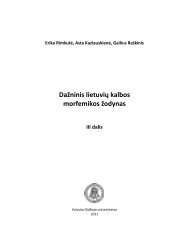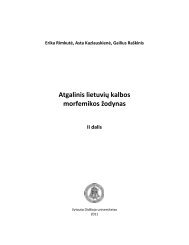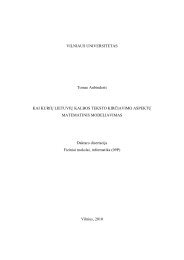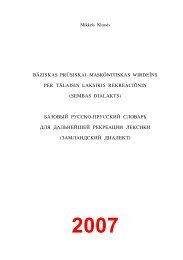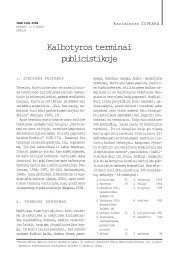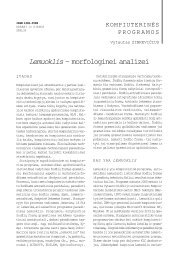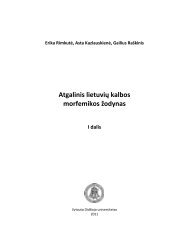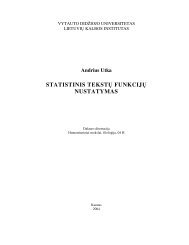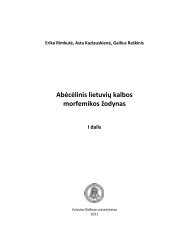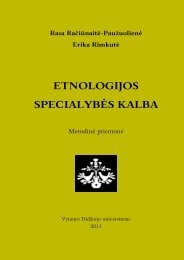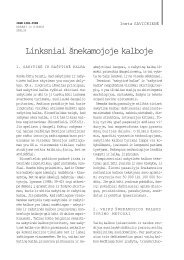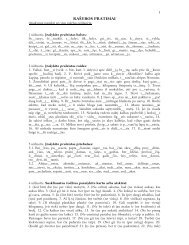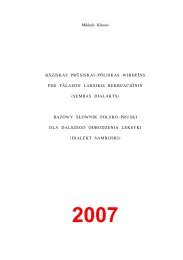HISTORICAL GRAMMAR OF OLD PRUSSIAN
HISTORICAL GRAMMAR OF OLD PRUSSIAN
HISTORICAL GRAMMAR OF OLD PRUSSIAN
Create successful ePaper yourself
Turn your PDF publications into a flip-book with our unique Google optimized e-Paper software.
<strong>HISTORICAL</strong> <strong>GRAMMAR</strong> <strong>OF</strong> <strong>OLD</strong> <strong>PRUSSIAN</strong><br />
15<br />
Vocalism<br />
a) Short vowels<br />
* 6. The short vowel Pr. *i comes from Balt. *i < IE *Ÿ and corresponds<br />
to Lith. i and Latv. i, cf.: Pr. is ‘from’ – Lith. Ñð (dial. iþ), Latv. iz;<br />
Pr. acc. kittan ‘other’ – Lith. kÑtà, Latv. cits; Pr. wissa – Lith. vÑsas, Latv.<br />
viss etc. There are instances of a syncopated short i in Prussian. e.g.:<br />
camstian ‘sheep’ (E) < *kamist’an (PEÞ II 105 ff.), werstian ‘calf’ (E) <<br />
*versist’an (PEÞ IV 231) 6 etc. In written documents short Pr. *i sometimes<br />
is rendered with the letter e, e.g.: camenis ‘hearth’ (E) < *kaminas<br />
(PEÞ II 103 f.), pekollin ‘hell’ (I) < *pikulin (for the spelling pyculs III<br />
reflecting *pik- see PEÞ III 280) etc. This shows an open character of Pr.<br />
*i (cf. Girdenis, Maþiulis in: Girdenis KD III 413 ff.). This does not<br />
contradict to such sample as meltan (E) ‘meal (fluor)’ (= *miltan), of course.<br />
For the phonetic value of the segment -el- cf. PEÞ III 125 f. as well as * 2.<br />
* 7. It is Baltic *Šu in which Pr. u, Lith. u and Latv. u originate, cf.:<br />
Pr. duckti ‘daughter’ (E) < *duktç (PEÞ I 235) – Lith. duktú; Pr. budç<br />
‘(they) are awake’ (III) – Lith. budêti, bùdinti and Latv. budinât ‘to wake’.<br />
That the short Pr. u was open in its turn (cf. about the Pr. i above), is<br />
witnessed again by the spelling, i.e. by variating o / u (cf. Girdenis KD l.<br />
c.), e.g.: Pr. meddo ‘honey’ (E) < *medu (the final inflection *‹u being<br />
unstressed, cf. PEÞ III 118) – Lith. medùs, Latv. medus; Pr. prusnan /<br />
prosnan ‘face’ (III) – Lith. prusn‡a ‘snout’, Latv. (pl.) prusnas ‘lips, mouth’<br />
(PEÞ III 361); druwç (III) / drowy (II) ‘(I) believe’. One should also pay<br />
attention to frequent rendering of ‹u with the letter o in unaccented<br />
inflexional morphemes in the Catechisms: acc. sg. dangon ‘heaven’ (I,<br />
III), sounon ‘son’ (III beside sunun I) etc., or if. daton ‘to give’ (III), bûton<br />
‘to be’ (III), pûton ‘to drink’ with -on instead of -un too, as well as pc. pt.<br />
act. auginnons ‘having grown’ (III) with -ons instead of -uns.<br />
* 8. Pr. *‹e comes from Balt. *‹e < IE *‹e and corresponds to Lith. e<br />
6 More precisely: camstian = *kamst’an or (sometimes supposed by Maþiulis earlier) *kamstjan<br />
< *kamistjan, werstian = *verst’an or werstjan < *versistjan – L.P.



